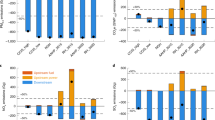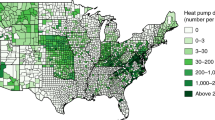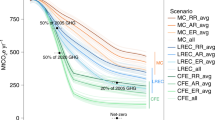Abstract
In the United Kingdom, natural gas dominates the provision of heating in buildings. In Sweden, oil heating has been largely replaced by district heating and heat pumps. The origins and outcomes of path dependence and lock-in in heat-system evolution can be country specific. Here, we compare case studies of heat transitions in the United Kingdom and Sweden, addressing the question: can path dependency help to understand why these countries have followed different paths in terms of change to their heating infrastructure? In both countries, the development of heating infrastructures can be understood as path-dependent processes, entailing increasing returns to adoption as fuel sources, infrastructures and end-use technologies coevolve such that the overall performance of the system increases. The challenge for policymakers seeking to achieve carbon targets is to consider how to create the conditions to encourage increasing returns to adoption of low-carbon heating solutions.
This is a preview of subscription content, access via your institution
Access options
Access Nature and 54 other Nature Portfolio journals
Get Nature+, our best-value online-access subscription
$29.99 / 30 days
cancel any time
Subscribe to this journal
Receive 12 digital issues and online access to articles
$119.00 per year
only $9.92 per issue
Buy this article
- Purchase on Springer Link
- Instant access to full article PDF
Prices may be subject to local taxes which are calculated during checkout



Similar content being viewed by others
References
Chaudry, M., Abeysekera, M., Hosseini, S., Jenkins, N. & Wu, J. Uncertainties in decarbonising heat in the UK. Energy Policy 87, 623–640 (2015).
Hanna, R., Parrish, B. & Gross, R. Best Practice in Heat Decarbonisation Policy: A Review of the International Experience of Policies to Promote the Uptake of Low-carbon Heat Supply (UK Energy Research Centre, 2016).
Vivid Economics & Imperial College London International Comparisons of Heating, Cooling and Heat Decarbonisation Policies (Department for Business, Energy and Industrial Strategy, 2017).
Next Steps for UK Heat Policy (Committee on Climate Change, 2016); https://www.theccc.org.uk/publication/next-steps-for-uk-heat-policy/
Homeowners’ Willingness to Take Up More Efficient Heating Systems (Department of Energy and Climate Change, 2013).
Smart Systems and Heat: Consumer Challenges for Low Carbon Heat (Energy Technologies Institute, 2015); https://s3-eu-west-1.amazonaws.com/assets.eti.co.uk/legacyUploads/2015/11/3501-Consumer-Insights.pdf?dl=1
Hannon, M. Raising the temperature of the UK heat pump market: learning lessons from Finland. Energy Policy 85, 369–375 (2015).
Werner, S. District heating and cooling in Sweden. Energy 126 (Suppl. C), 419–429 (2017).
Bouzarovski, S., Sýkora, L. & Matoušek, R. Locked-in post-socialism: rolling path dependencies in Liberec’s district heating system. Eurasia. Geogr. Econ. 57, 624–642 (2016).
Poputoaia, D. & Bouzarovski, S. Regulating district heating in Romania: legislative challenges and energy efficiency barriers. Energy Policy 38, 3820–3829 (2010).
Fouquet, R. Path dependence in energy systems and economic development. Nat. Energy 1, 16098 (2016).
Arthur, W. Competing technologies, increasing returns, and lock-in by historical events. Econ. J. 99, 116–131 (1989).
David, P. in Evolution and Path Dependence in Economic Ideas: Past and Present (eds Garrouste, P. & Ioannides, S.) Ch. 2 (Edward Elgar, 2000).
Pierson, P. Increasing returns, path dependence, and the study of politics. Am. Polit. Sci. Rev. 94, 251–267 (2000).
Unruh, G. Understanding carbon lock-in. Energy Policy 28, 817–830 (2000).
Pearson, P. in Innovation and Disruption: The Energy Sector in Transition (British Institute of Energy Economics, 2016).
Heiskanen, E., Lovio, R. & Jalas, M. Path creation for sustainable consumption: promoting alternative heating systems in Finland. J. Clean. Prod. 19, 1892–1900 (2011).
Heat Pumps Barometer (EurObserv’ER, 2015); https://www.eurobserv-er.org/pdf/2015/EurObservER-Heat-Pumps-Barometer-2015-EN.pdf
Pearson, P. & Arapostathis, S. Two centuries of innovation, transformation and transition in the UK gas industry: Where next? Proc. Inst. Mech. Eng. A 231, 478–497 (2017).
2050 Energy Scenarios: The UK Gas Networks Role in a 2050 Whole Energy System (KPMG for Energy Networks Association, 2016); https://www.energynetworks.org/assets/files/gas/futures/KPMG%20Future%20of%20Gas%20Main%20report%20plus%20appendices%20FINAL.pdf
Frontier Economics Pathways to High Penetration of Heat Pumps (Committee on Climate Change, 2013).
Hanmer, C. & Abram, S. Actors, networks, and translation hubs: gas central heating as a rapid socio-technical transition in the United Kingdom. Energy Res. Soc. Sci. 34, 176–183 (2017).
Arapostathis, S. et al. Governing transitions: cases and insights from two periods in the history of the UK gas industry. Energy Policy 52, 25–44 (2013).
United Kingdom Housing Energy Fact File 2013 (Department of Energy and Climate Change, 2013).
Energy Consumption in the UK 2017 Data Tables: Table 3.18 (Department for Business, Energy and Industrial Strategy, accessed 31 May 2018); https://www.gov.uk/government/statistics/energy-consumption-in-the-uk
Jeremiah, D. Architecture and Design for the Family in Britain, 1900–1970 (Manchester Univ. Press, 2000).
Scarrow, H. The impact of British domestic air pollution legislation. Br. J. Polit. Sci. 2, 261–282 (1972).
Homes for Today and Tomorrow (Ministry of Housing and Local Government, 1961).
Kuijer, L. & Watson, M. ‘That’s when we started using the living room’: lessons from a local history of domestic heating in the United Kingdom. Energy Res. Soc. Sci. 28, 77–85 (2017).
Utley, J. & Shorrock, L. Domestic Energy Fact File 2008 (Building Research Establishment, 2008); https://www.bre.co.uk/filelibrary/pdf/rpts/Fact_File_2008.pdf
Gross, R. et al. Presenting the Future: An Assessment of Future Costs Estimation Methodologies in the Electricity Generation Sector (UK Energy Research Centre, 2013).
Weiss, M., Dittmar, L., Junginger, M., Patel, M. & Blok, K. Market diffusion, technological learning, and cost-benefit dynamics of condensing gas boilers in the Netherlands. Energy Policy 37, 2962–2976 (2009).
Arapostathis, S., Pearson, P. & Foxon, T. UK natural gas system integration in the making, 1960–2010: complexity, transitional uncertainties and uncertain transitions. Environ. Innov. Soc. Transit. 11, 87–102 (2014).
Ericsson, K. Introduction and Development of the Swedish District Heating Systems: Critical Factors and Lessons Learned (European Commission, 2009); https://ec.europa.eu/energy/intelligent/projects/sites/iee-projects/files/projects/documents/res-h_policy_introduction_and_development_of_swedish_dh_systms_en.pdf
Di Lucia, L. & Ericsson, K. Low-carbon district heating in Sweden — examining a successful energy transition. Energy Res. Soc. Sci. 4, 10–20 (2014).
Renewable Heat Policies: Delivering Clean Heat Solutions for the Energy Transition (International Energy Agency, 2018).
Sumner, J., Bird, L. & Smith, H. Carbon Taxes: A Review of Experience and Policy Design Considerations Technical Report NREL/TP-6A2-47312 (National Renewable Energy Laboratory, 2009); http://www.nrel.gov/docs/fy10osti/47312.pdf
State and Trends of Carbon Pricing 2014 (Ecofys, World Bank, 2014); http://documents.worldbank.org/curated/en/505431468148506727/State-and-trends-of-carbon-pricing-2014
Mahapatra, K. & Gustavsson, L. Influencing Swedish homeowners to adopt district heating system. Appl. Energy 86, 144–154 (2009).
Andrews, D. et al. Background Report on EU-27 District Heating and Cooling Potentials, Barriers, Best Practice and Measures of Promotion (European Commission Joint Research Centre, 2012).
Patronen, J., Kaura, E. & Torvestad, C. Nordic Heating and Cooling: Nordic Approach to EU’s Heating and Cooling Strategy (Nordic Council of Ministers Denmark, 2017).
Oñate, V., Kessels, K. & Six, D. Best-practices for district heating implementation in Belgium: policy analysis and benchmark from countries with high market penetration. In 2014 IEEE International Energy Conference (ENERGYCON) 1027–1033 (IEEE, 2014).
Kiss, B., Neij, L. & Jakob, M. in Energy Technology Innovation: Learning from Historical Successes and Failures (eds Grubler, A. & Wilson, C.) Ch. 9 (Cambridge Univ. Press, 2014).
Sandstrom, B. Swedish experience with subsidies for heat pump installations. European Heat Pump News (European Heat Pump Association, 2000).
Johansson, P. Value Network Dynamics in Sustainability Transitions: The Role of Industry Incumbents in the Swedish Heat Pump Transition (International Sustainability Transitions Conference, 2016); http://kth.diva-portal.org/smash/record.jsf?pid=diva2%3A1082004&dswid=6773
Zimny, J., Michalak, P. & Szczotka, K. Polish heat pump market between 2000 and 2013: European background, current state and development prospects. Renew. Sustain. Energy Rev. 48, 791–812 (2015).
European Heat Pump Market and Statistics Report 2014 (European Heat Pump Association, 2014).
Kiss, B., Neij, L. & Jakob, M. in Global Energy Assessment (eds Johansson, T., Patwardhan, A., Nakićenović, N. & Gomez-Echeverri, L.) Ch. 24 (Cambridge Univ. Press, 2012).
Dzebo, A. & Nykvist, B. A new regime and then what? Cracks and tensions in the socio-technical regime of the Swedish heat energy system. Energy Res. Soc. Sci. 29, 113–122 (2017).
Harris, M. Thermal Energy Storage in Sweden and Denmark: Potentials for Technology Transfer. MSc thesis, Lund Univ. (2011).
Forsen, M., Roots, P. & Bertenstam, A. Market Status for Ground Source Heat Pumps in Europe (European Commission, 2008); https://ec.europa.eu/energy/intelligent/projects/sites/iee-projects/files/projects/documents/ground-reach_market_status_for_gchp_in_europe.pdf
Arthur, W. Increasing Returns and Path Dependence in the Economy (Univ. Michigan Press, 1994).
Abramovitz, M. Resource and output trends in the United States since 1870. Am. Econ. Rev. 46, 5–23 (1956).
Solow, R. Technical change and the aggregate production function. Rev. Econ. Stat. 39, 312–320 (1957).
Arrow, K. The economic implications of learning by doing. Rev. Econ. Stud. 29, 155–173 (1962).
Perkins, R. Technological ‘lock-in’. In Internet Encyclopedia of Ecological Economics (International Society for Ecological Economics, 2003).
Foray, D. The dynamic implications of increasing returns: technological change and path dependent inefficiency. Int. J. Ind. Organ. 15, 733–752 (1997).
European Heat Pump Market and Statistics Report 2017 (European Heat Pump Association, 2017).
Acknowledgements
The research on which this paper is based was undertaken as part of the research programme of the UK Energy Research Centre – Phase 3, which is funded by the UK Research and Innovation Energy Programme (grant reference EP/L024756/1). Part-funding for the original research was also provided by the Committee on Climate Change. Subsequent funding was provided by the Department for Business, Energy and Industrial Strategy for which the authors contributed to a review of international heating and cooling decarbonization policies led by Vivid Economics.
Author information
Authors and Affiliations
Corresponding authors
Ethics declarations
Competing interests
The authors declare no competing interests.
Additional information
Publisher’s note: Springer Nature remains neutral with regard to jurisdictional claims in published maps and institutional affiliations.
Rights and permissions
About this article
Cite this article
Gross, R., Hanna, R. Path dependency in provision of domestic heating. Nat Energy 4, 358–364 (2019). https://doi.org/10.1038/s41560-019-0383-5
Received:
Accepted:
Published:
Issue Date:
DOI: https://doi.org/10.1038/s41560-019-0383-5
This article is cited by
-
A relational approach to characterizing householder perceptions of disruption in heat transitions
Nature Energy (2024)
-
Decarbonization pathways for the residential sector in the United States
Nature Climate Change (2022)
-
Heating up the global heat pump market
Nature Energy (2022)
-
Heat Roadmap Europe: strategic heating transition typology as a basis for policy recommendations
Energy Efficiency (2022)
-
The role of heat pump in heating decarbonization for China carbon neutrality
Carbon Neutrality (2022)



